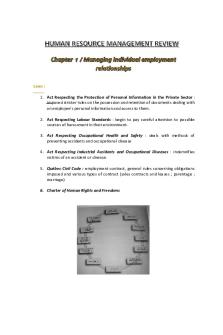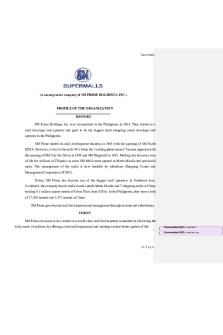HRM case study - Human resource management case PDF

| Title | HRM case study - Human resource management case |
|---|---|
| Course | STRATEGIC MANAGEMENT |
| Institution | United States International University Africa |
| Pages | 5 |
| File Size | 65.1 KB |
| File Type | |
| Total Downloads | 20 |
| Total Views | 150 |
Summary
Human resource management case...
Description
1
HRM Case Study
Name Institutional affiliation Instructor’s title and name Course Date
2 1. The city could have avoided firing Mr. McCree directly after he failed the drug test. Instead, the city could have used Mr. McCree’s coworkers to try and counsel him about his behavior. Since some of the coworkers were his friends, they could have managed to calm his anger and minimize his troubles. Although his supervisors had counseled him about controlling his temper, they were not qualified psychiatrists (Klingner et al., 2017). Since Mr. McCree was abusing drugs, the city should have considered sending him to a qualified psychology expert for evaluation and counselling. Still, the supervisors continued to give him satisfactory performance assessment for nine years despite his troubles at work. The city should started to address the problem by evaluating him based on his behavior so that he would start to understand that the impact of his temper on coworkers (Klingner et al., 2017). If McCree had received a poor performance evaluation, there is a possibility that he would have thought about addressing his behavior in order to save his job. 2. The standard of foreseeability is applied to establish the proximate cause of after an incident. The foreseeability test seeks to determine whether the party being accused for causing the injury or this case death, should have reasonably foreseen the overall consequences that would result due to their action. In the case the standard of foreseeability could be applied to charge the city for failure to take timely action against Clifton McCree (Klingner et al., 2017). The city knew that McCree had a violent history. Throughout his career at the Park and Recreation Department he had problems controlling his temper and often accused his supervisors and coworkers for racism (Klingner et al., 2017). Based on the violent history and the drug test results, the city should have foreseen the possibility of Mr. McCree retaliating for losing his job.
3 Furthermore, his coworkers and supervisors preferred handling confrontations and complaints internally, due to the fear of retaliation in case he lost his job (Klingner et al., 2017). Although the city may argue that they acted based on the new policy that came in place in 1994, they should have foreseen the possibility of retaliation when the fired McCree and when he failed to find a new job. 3. The city’s prompt action of firing Mr. McCree based on the new workplace violence increased his chances of workplace violence. The action to dismiss Mr. McCree served to increase his paranoia and beliefs of being targeted because of his race. Since the events leading to his dismissal happened quickly, he perceived it as a plan to get him out of the city’s workforce (Klingner et al., 2017). The dismissal decisions was also based on the accounts that his coworkers gave when interviewed by the city officials. The action increased the violence thoughts against his coworkers because he believed they disclosed his misconduct to the city officials (Klingner et al., 2017). 4. HRM leaders can prevent factors such as ethnic unrest, drug abuse as well as disgruntled workers with access to weapons from resulting into a workplace tragedy by working with various community stakeholders to offer assistance. The HRM can organize for off-site services such as counseling to help minimize the possibility of the disgruntled employee causing workplace violence (Agovino, 2019). The counseling service can help to change the terminated employee’s perspective and help them plan for their future life after leaving the respective organization. Working with community organizations can help to train the dismissed employee in order to enhance his future job performance (Agovino, 2019). However, the services should be provided
4 outside the workplace as a precaution to prevent the terminated worker from returning to the organization.
5 Reference Agovino, T. (2019, June 28). Safeguarding Employees from Workplace Violence. SHRM. https://www.shrm.org/hr-today/news/all-things-work/pages/safeguarding-employeesfrom-workplace-violence.aspx Klingner, D.E., Nalbandian, J., & Llorens, J., (2017). Public personnel management, seventh editition. Longman/Pearson higher Education....
Similar Free PDFs

Human Resource Management Case Study
- 14 Pages

Hrm - human resource report
- 10 Pages

Case study HRM
- 2 Pages

Case study HRMT - HRM
- 13 Pages

HRM Case - Case
- 10 Pages

Human Resource Management Review
- 40 Pages

human resource management
- 3 Pages
Popular Institutions
- Tinajero National High School - Annex
- Politeknik Caltex Riau
- Yokohama City University
- SGT University
- University of Al-Qadisiyah
- Divine Word College of Vigan
- Techniek College Rotterdam
- Universidade de Santiago
- Universiti Teknologi MARA Cawangan Johor Kampus Pasir Gudang
- Poltekkes Kemenkes Yogyakarta
- Baguio City National High School
- Colegio san marcos
- preparatoria uno
- Centro de Bachillerato Tecnológico Industrial y de Servicios No. 107
- Dalian Maritime University
- Quang Trung Secondary School
- Colegio Tecnológico en Informática
- Corporación Regional de Educación Superior
- Grupo CEDVA
- Dar Al Uloom University
- Centro de Estudios Preuniversitarios de la Universidad Nacional de Ingeniería
- 上智大学
- Aakash International School, Nuna Majara
- San Felipe Neri Catholic School
- Kang Chiao International School - New Taipei City
- Misamis Occidental National High School
- Institución Educativa Escuela Normal Juan Ladrilleros
- Kolehiyo ng Pantukan
- Batanes State College
- Instituto Continental
- Sekolah Menengah Kejuruan Kesehatan Kaltara (Tarakan)
- Colegio de La Inmaculada Concepcion - Cebu








